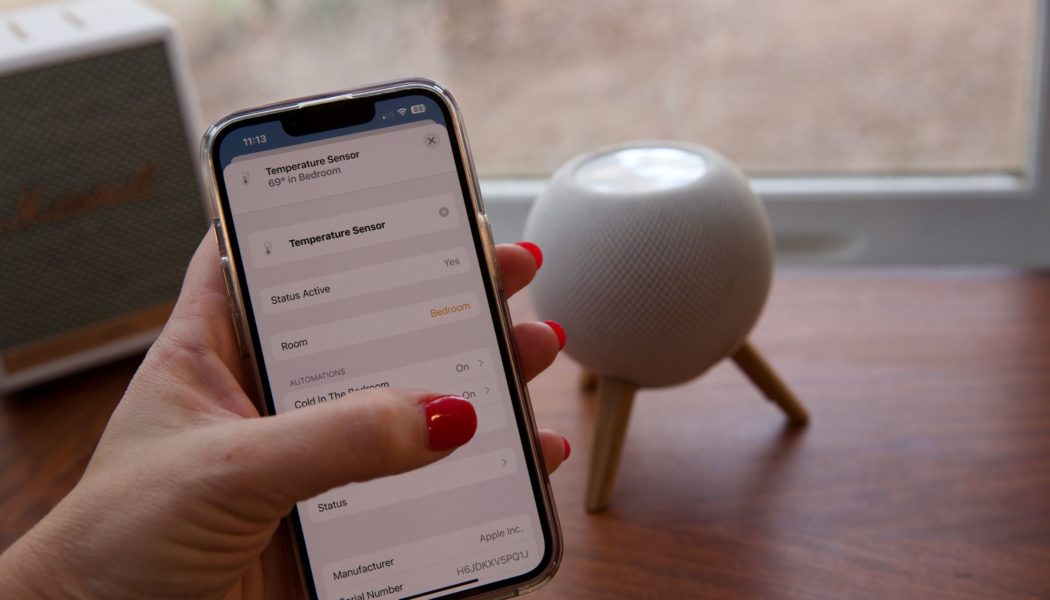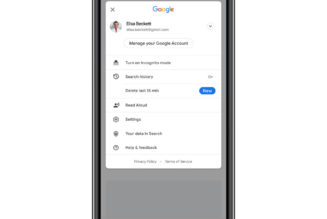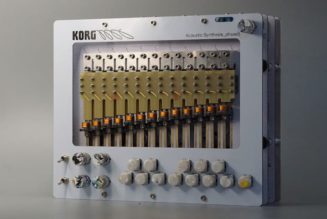Apple’s smallest smart speaker is about to get a big update. We tried out some of the new features — including temperature and humidity sensing, enhanced Find My options, and knowing when to be quiet.
:format(webp)/cdn.vox-cdn.com/uploads/chorus_asset/file/24371457/8A0A7684.jpeg)
While the sort of new HomePod grabbed all the attention this week, the HomePod Mini is also getting some new features. With the launch of iOS 16.3 (likely later this month), the Mini will get all the same smart home capabilities as the new, bigger HomePod second-gen. The differences between the two Apple speaker siblings are now mainly in size and sound capability. From new temperature and humidity sensing tricks to the ability to find your family for you and even set up automations with just your voice, these new features should make the HomePod Mini a little more useful around the house.
Both HomePods are also getting a Sound Recognition feature later this year, allowing them to listen for smoke and carbon monoxide alarms. I saw a preview of this, and it looks like a useful integration, allowing you to talk directly to anyone in your home through the HomePod from a notification on your lock screen. But my favorite new capability is something Siri now won’t do — which is to talk back to you every time you ask it to turn off the lights. I like my voice assistants to say as little as possible.
The new capabilities will show up automatically once you update your devices to iOS 16.3 and HomePod software version 16.3, which should be available later this month. However, the Release Candidate of the iOS 16.3 beta landed on Wednesday, so I downloaded it to get an early look at some of these new features. Here are some first impressions.
a:hover]:shadow-highlight-franklin [&>a]:shadow-underline-black dark:[&>a:hover]:shadow-highlight-franklin dark:[&>a]:shadow-underline-white md:text-30″>Temperature and humidity sensing
We’ve known that the HomePod Mini had a temperature and humidity sensor onboard for a while, but it’s been dormant since launch. With HomePod software version 16.3, the chip is getting its wake-up call, and once your HomePod Mini is updated, it can start to monitor the temperature and humidity for you in the room it’s in.
You can see the readings at a glance in the Home app on iOS and iPad OS devices that are also updated to 16.3. The easiest way is to tap on the Climate shortcut at the top of the homescreen, which shows the readings of all temperature and humidity sensors in your home.
In the app, you can also see the readings at the top of the room the speaker is in. If you have multiple temperature sensors in the room, it will display an average of them. Tap on the reading to get to the individual sensor’s readings and settings.
Here, you can rename the sensors. Oddly, the HomePod sensors showed up with different default names on each of the two HomePod Minis I have. On one, they came through as Humidity Sensor and Temperature Sensor, and on the other, they came through with a more generic HomePod Sensor136480.
You can create automations from this settings page to do things like trigger other smart home devices to respond to the temperature or humidity rising above or dropping below a certain threshold. You can also create scenes and automations using the sensors through the automations tab of the app.
As with most Apple Home automations, you can set parameters using time (any time, during the day, at night, or specific times) and / or people (when somebody is home, when I am home, when nobody is home, or when I am not home).
I successfully created an automation to turn on the heat on the mini-split unit in my bedroom to 68 degrees Fahrenheit when the temperature drops below 66 degrees Fahrenheit and then to turn on the AC when it gets above 76.
I also tested the HomePod Mini’s readings against an Aqara indoor air quality monitor, and they were consistently close, only varying by a degree at any one time on temperature and by around 2 percent on humidity.
Apple does warn that the sensors are optimized for ambient temperatures around 69 degrees Fahrenheit and 86 degrees Fahrenheit and that accuracy isn’t guaranteed when the speaker is playing music for long periods of time at high volumes. (I haven’t tested this yet.)
Other potential automations the sensors could be used for include lowering smart shades if the temperature rises in the afternoon when the sun may add radiant heat to the room — or to turn on a fan connected to a smart plug when the temperature rises or activate a compatible smart humidifier when the humidity drops below a certain point.
One thing I would like to be able to do that I couldn’t is set it to send a notification when the temperature or humidity changes significantly — which would be helpful, say, in a nursery.
:format(webp)/cdn.vox-cdn.com/uploads/chorus_asset/file/24372354/8A0A7667.jpeg)
Currently, it looks like you can only set up automations with the sensors in Apple Home, not third-party HomeKit apps such as Eve, Home Plus, and Controller, as HomePod speakers don’t show up in these other apps. This likely means the sensors also won’t be exposed to Matter, but that hasn’t been confirmed.
You can also ask Siri what the temperature or humidity is in the room, and it will respond with a specific reading from its sensor or an average if you have multiple sensors in the room.
:format(webp)/cdn.vox-cdn.com/uploads/chorus_asset/file/24372381/8A0A7678.jpeg)
a:hover]:shadow-highlight-franklin [&>a]:shadow-underline-black dark:[&>a:hover]:shadow-highlight-franklin dark:[&>a]:shadow-underline-white md:text-30″>Find your family
The HomePod Mini can now track your family and friends for you as well as any items you have connected to Find My through AirTags or any Find My-enabled devices. Just say, “Hey Siri, where is [insert name of a family member or friend or item]?”
I find Apple’s Find My feature to be a bit spotty. It always struggles to find my daughter, who has an Apple Watch, not an iPhone. But I tested this feature on my son with his iPhone 13, and it located him easily, replying with his distance and location to a nearby address. I also tested it with an AirTag connected to a backpack, and it responded accurately.
a:hover]:shadow-highlight-franklin [&>a]:shadow-underline-black dark:[&>a:hover]:shadow-highlight-franklin dark:[&>a]:shadow-underline-white md:text-30″>Set up Apple Home automations with your voice
You can now set up recurring Apple Home automations using Siri on the HomePod Mini. I tried to create one to lock my front door every night at 9PM and had a little trouble at first. The language has to be very precise; it didn’t like “every night,” so I had to say “every day.” But I eventually got it to work with this language:
“Hey Siri, set an automation to lock the front door at 9PM every day.”
Siri replied with a confirmation: “I’ve set the Yale lock to lock at 9PM starting this evening.”
I’m not sure how much I’ll use this ability, personally, but I can see it being a precursor to Siri potentially suggesting to set up automations for you, similar to Amazon Alexa’s hunches feature.
a:hover]:shadow-highlight-franklin [&>a]:shadow-underline-black dark:[&>a:hover]:shadow-highlight-franklin dark:[&>a]:shadow-underline-white md:text-30″>Siri now says less
Siri is my preferred voice assistant for smart home control, mainly because it doesn’t try to muscle in on the conversation as much as some of its competitors. But lately, it’s become more verbose. This update fixes that somewhat by replacing the sometimes long confirmation of actions following a smart home command with just a soft ding ding.
This applies to actions that involve devices not in the same room as the HomePod (for which Siri already only plays a confirmation sound) or ones that don’t show a visual change — like a heater.
Now, when I ask Siri on the HomePod Mini to turn the lights off in, say, the kitchen while I’m in the bedroom, instead of confirming audibly that the lights are off, there’s just a small sound to indicate that my will has been done.
However, if something goes wrong, it will still say, “I tried but some devices didn’t respond.”
a:hover]:shadow-highlight-franklin [&>a]:shadow-underline-black dark:[&>a:hover]:shadow-highlight-franklin dark:[&>a]:shadow-underline-white md:text-30″>Ambient sounds can now be part of scenes and automations
Finally, Apple says it’s remastered the ambient sounds on the HomePod Mini, including ocean, white noise, fireplace, and rain. These noises can now be added to scenes, automations, and alarms.
I tested this out with a Bedtime Scene I have that turns off lights, locks the doors, and adjusts the thermostat, and I was able to add ocean sounds playing on the HomePod to it. I could set the volume it would play at when the scene was activated, but I couldn’t set a time for it to turn off, which is something I’d like to see added.
Overall, these new features bring some much-needed functionality to the HomePod line (all of them will be on the new HomePod, too), which has been playing catch-up in terms of functionality to Amazon’s Echo devices. Those speakers have had sound recognition for a while now. They also can act as motion sensors and can reply in a whisper if you talk quietly to them, features I’d like to see come to the HomePod line, too. Just as long as Siri doesn’t pick up on Alexa’s “by the way” habit, where Amazon’s assistant offers what it thinks is helpful information entirely unprompted. It’s rarely helpful and often involves asking you to spend money.
Photography by Jennifer Pattison Tuohy / The Verge








